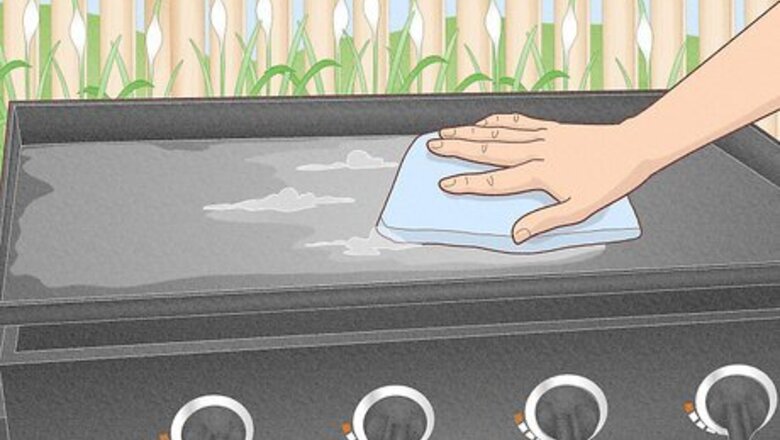
views
- Before you use it for the first time, clean the griddle with hot soapy water. Then, apply 3–4 thin layers of cooking oil to season the surface.
- After you cook on your griddle, remove food residue with a metal scraper. Season your griddle with a layer of cooking oil.
- To clean a rusty Blackstone griddle, scrub the surface with a grill brick and cooking oil.
Before First Use

Wash your Blackstone griddle with hot soapy water. Fill a bowl with hot water and a few squirts of dish soap. Wet a lint-free cloth in the soapy water and rub it over the surface of your griddle top to remove the protective coating leftover from shipping. When you’re finished scrubbing the surface, rinse your griddle off and dry it with another towel. This is the only time you’ll use soap to clean your griddle. If you use soap any other time, it will strip the non-stick seasoning off of the surface.
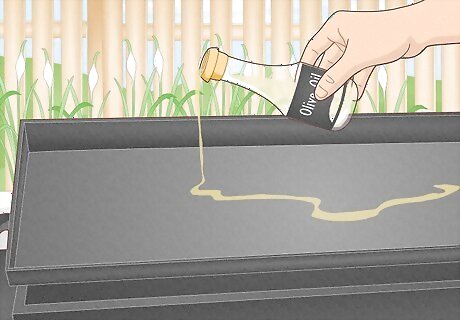
Spread 2–3 US tbsp (30–44 ml) of cooking oil on the griddle. Use flax oil, extra virgin olive oil, canola oil, or vegetable oil to season your Blackstone griddle. Pour the oil directly onto the griddle top and wipe it onto the surface with a few paper towels. Spread the oil into a thin, even layer across the entire surface. If you don’t have any cooking oil, you can use shortening instead. Seasoning your Blackstone griddle protects it from developing rust and creates a non-stick surface.
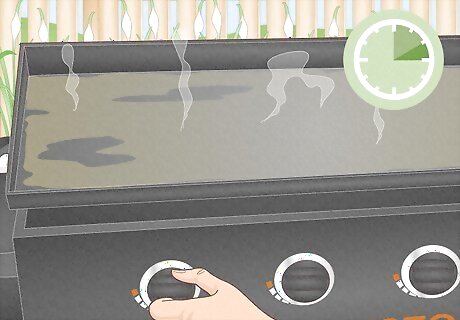
Turn the griddle on high for 10–15 minutes until the oil stops smoking. Turn the dials on the front of your griddle to the highest heat setting and let it warm up completely. As the griddle heats up, the oil will start to smoke and create a non-stick surface. After about 15 minutes, all the oil will finish cooking off, so turn off your griddle and let it cool down completely.
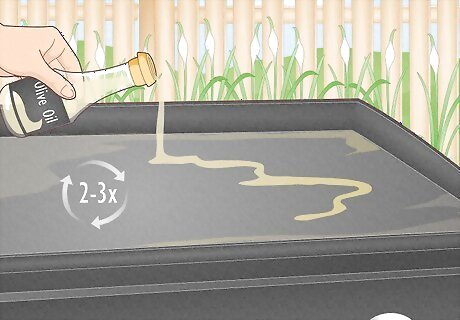
Apply and heat 2–3 more coats of cooking oil. Once your griddle is cool, put another 2–3 US tbsp (30–44 ml) of oil in a thin layer onto the surface. Warm the oil up over high heat until it completely stops smoking. When your griddle has a smooth, black finish, then it’s completely seasoned and ready to cook with. Cooking before you completely season your griddle could make it rust prematurely or cause food to stick to the surface.
After Cooking
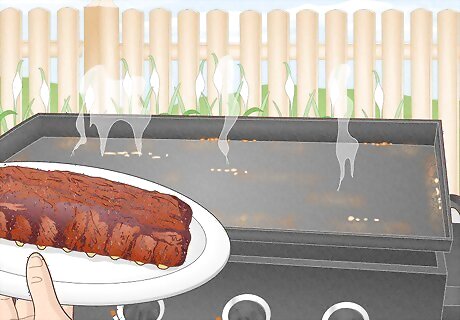
Clean your griddle while it’s still hot. As soon as you finish cooking your meal, make it a habit to clean your Blackstone griddle right away. Turn the burners off before you start cleaning, but just be sure to scrub them before they start to cool down. Cleaning your griddle while it’s still hot makes it easier to remove food residue before it dries onto the surface.
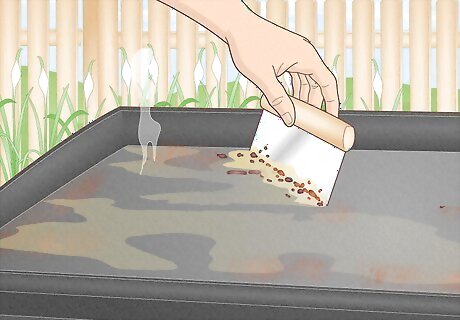
Remove food and cooking oil with a metal scraper. Hold the scraper so the blade makes a 30- or 45-degree angle. Start at the front corner on one side of your cooktop. Apply gentle, even pressure and push the scraper toward the back corner of the griddle. Work the scraper all the way across your surface, and push any food scraps or dirty oil into the grease trap at the back of the griddle. If you don’t have a metal scraper tool, then try using a metal spatula instead. Be careful not to press down too hard into the griddle top since you could remove the seasoning from the surface. Wear Blackstone heat-resistant gloves to help protect your hands while you’re cleaning.
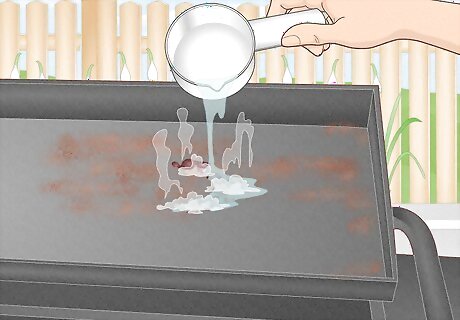
Pour water on tough residue to boil it off. If there's some stubborn grease stuck on the surface, coat the area with water. If the water doesn’t start to bubble or boil right away, turn the burner back on to heat it up. After the water boils for a few minutes or turns to steam, try running your scraper over the area again to remove the grease. It may take a few tries to completely remove stubborn food with water. If you still can’t remove stuck-on residue with water, then scrub at it with steel wool. Just be aware that this damages the seasoning on the griddle, so make sure you season it with cooking oil like you did when you first cleaned it. Avoid using any soap since it could stick to the seasoning and make your meals taste soapy in the future. Too much soap could even strip off the existing coating.
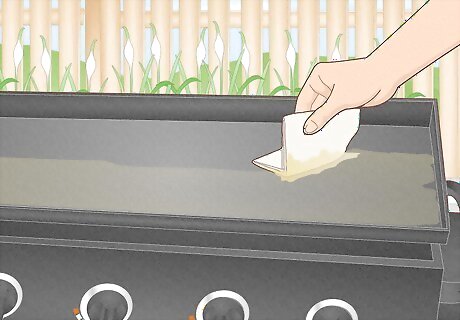
Wipe your griddle dry with a paper towel or clean lint-free cloth. Fold your paper towel or cloth and run it over the griddle surface to clean off the excess water and leftover oil. If the griddle is still too hot to touch, hold the paper towel or cloth with a pair of tongs.
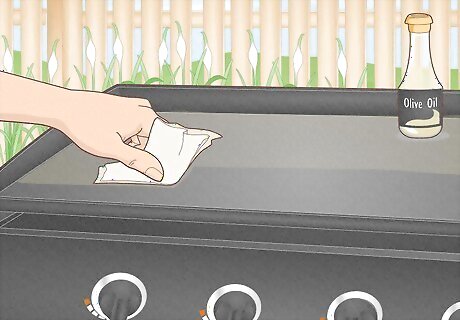
Apply a thin layer of cooking oil to your griddle. Use flax oil, extra virgin olive oil, canola oil, or vegetable oil. Pour about 1 tablespoon (15 ml) of oil onto the surface and rub it in with paper towels. Spread the oil into a thin, even layer across the entire surface to help maintain the seasoning. Don’t forget to coat the sides of the griddle with oil as well. If you don’t have cooking oil, apply a thin layer of non-stick cooking spray instead.
Restoring a Rusted Griddle
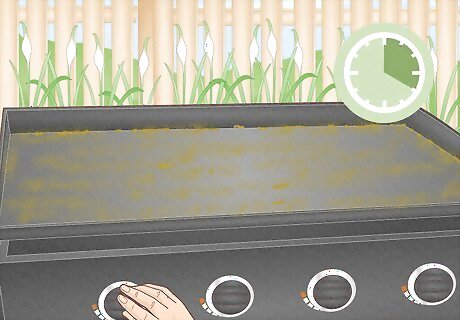
Set your griddle to high heat for 20 minutes to loosen the rust. Turn your griddle to the highest heat setting and let it warm up completely. Leave your griddle on so the rust breaks apart from the surface so it’s easier to remove. After 20 minutes, turn your griddle off and let it cool down completely. You can try to scrape the rust off your griddle before you heat it, but you’ll probably be more successful after it warms up.
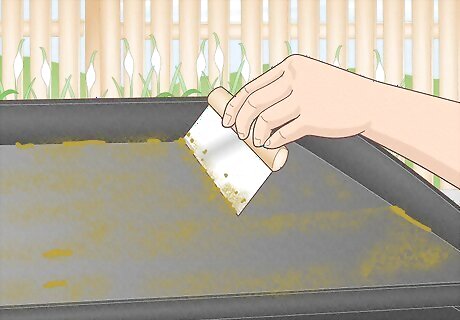
Clean off the debris with a metal scraper. Hold your metal scraper at a 45-degree angle, and apply firm pressure against your griddle top. Move the scraper across the surface of your griddle, focusing on the really rusty areas. Try to break apart as much of the rust on the surface as you can. Scoop the residue into the trash or push it into the grease trap at the back of the griddle.
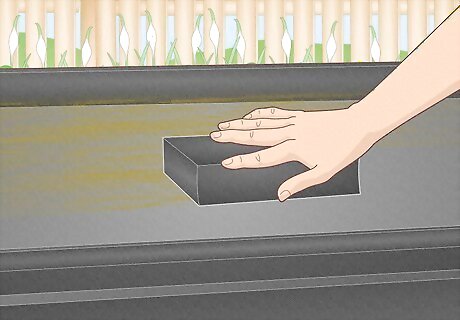
Scrub your griddle top with grill brick and cooking oil. Pour about 1 tablespoon (15 ml) of flax oil, extra virgin olive oil, canola oil, or vegetable oil onto your griddle. Set your grill brick on top of the oil. Press down firmly with the brick and move it across the surface of your griddle in a circular motion. Focus on any areas where you feel resistance since that means there’s residue raised above the surface. Work your way across the entire cooktop with the brick. A grill brick is a large, abrasive cleaner that helps remove rust and stuck-on residue from your Blackstone griddle. Get a Blackstone cleaning kit that has a grill brick with an attachable handle so it’s easier to use. If you don’t have a grill brick, use steel wool instead.
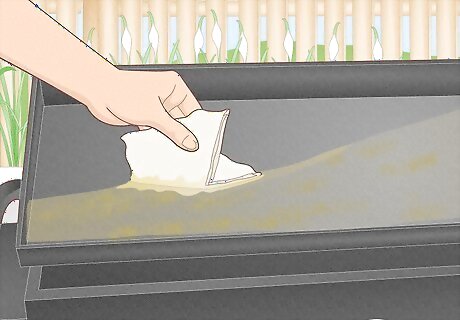
Wipe up the dirty oil with paper towels. Run clean paper towels across the top of your Blackstone griddle. Guide all of the food residue, rust, and oil toward the grease trap at the back of the griddle top so you have a nice, clean surface. Then, just toss the paper towels away in your trash can.
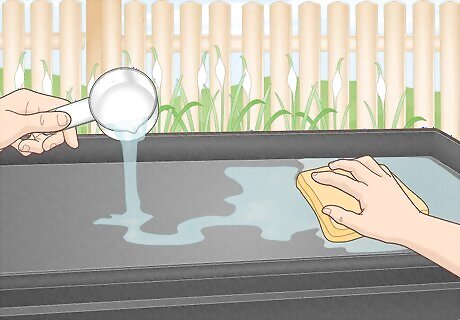
Rinse your griddle with water and dry it off with a lint-free towel. Pour a little water onto your griddle to help pick up any leftover residue you didn’t pick up. Immediately run your towel over the surface to wipe it up so your griddle is completely dry. Removing rust also takes the seasoning off of your griddle, so leaving water on the surface could lead to more rust forming.
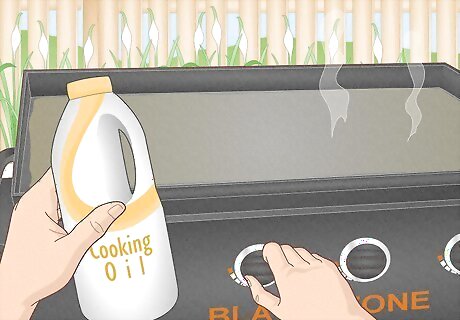
Season your griddle with cooking oil to restore the finish. Spread a thin layer of cooking oil over the entire surface of your Blackstone griddle. Turn the griddle onto high heat and let it sit for about 15 minutes until the oil finishes smoking. Let the griddle cool down afterward. Then, repeat the process 2–3 more times until the griddle has a black, non-stick finish again. Rust forms when your griddle is left exposed to the elements. Put a griddle bag on when you’re not using your cooktop for additional protection.

















Comments
0 comment